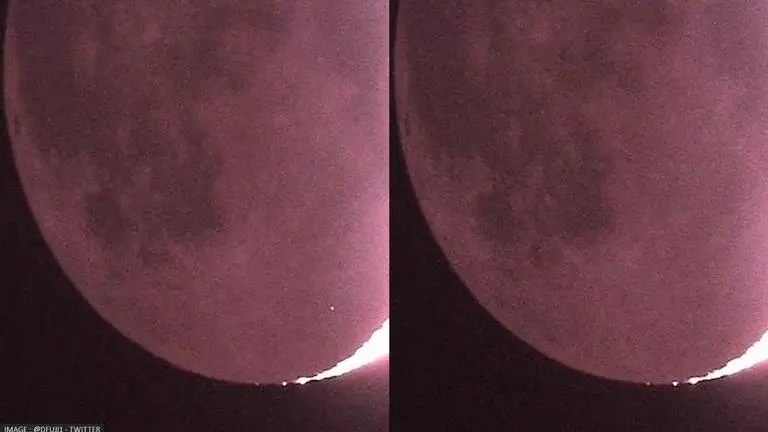Updated 12 March 2023 at 23:13 IST
Japanese astronomer captures telltale flash after Meteorite crashes into moon: Watch
Japanese astronomer and the curator of the Hiratsuka Museum, Daichi Fujii captured a video of a flash that was generated after a Meteorite crashed into moon.
- Science News
- 3 min read

Japanese astronomer and the curator of the Hiratsuka City Museum, Daichi Fujii captured a marvellous video of a flash that was generated after a Meteorite crashed into a moon. According to Sputnik, the flash was recorded at 20:14:30.8 Japan Standard Time on February 23. In a tweet, Fujii asserted that the meteorite crashed near “Ideler L crater”, which is located slightly northwest of Pitiscus Crater. While meteorites heading towards the Earth is a regular ordeal, the vast majority of them burn up completely before they even enter the Earth’s atmosphere. However, Earth's satellite, on the other hand, has a thin exosphere which enables the meteorite to crash on Earth’s surface without getting all burned up.
“I was able to catch the biggest lunar impact flash in my observation history! This is a picture of the lunar impact flash that appeared at 20:14:30.8 on February 23, 2023, taken from my home in Hiratsuka (replayed at actual speed),” Fujii wrote on Twitter on November 25. “It was a huge flash that continued to shine for more than 1 second. Since the moon has no atmosphere, meteors and fireballs cannot be seen, and the moment a crater is formed, it glows,” the Japanese astronomer added.
According to the Japanese astronomer, the marvellous visuals were captured by him from his telescope at home. Fujii made it clear that during the time of impact, no artificial satellite was revolving around the moon which would have caused the flash. “This is a picture of the lunar impact flash at 20:14:30.8 on February 23, 2023, captured by another telescope (playback at actual speed). At that time, the altitude of the moon was only 7 degrees, and I was glad that I was able to hold on until the last minute. At the time of observation, there was no artificial satellite passing over the lunar surface, and from the way it shines, it is likely a lunar impact flash,” the Japanese astronomer wrote further.
私の観測史上最大の月面衝突閃光を捉えることができました!2023年2月23日20時14分30.8秒に出現した月面衝突閃光を、平塚の自宅から撮影した様子です(実際の速度で再生)。なんと1秒以上も光り続ける巨大閃光でした。月は大気がないため流星や火球は見られず、クレーターができる瞬間に光ります。 pic.twitter.com/Bi2JhQa9Q0
— 藤井大地 (@dfuji1) February 24, 2023
2023年2月23日20時14分30.8秒の月面衝突閃光を、別の望遠鏡で捉えた様子です(実際の速度で再生)。このとき月の高度はわずか7度で、ぎりぎりまで粘ってよかったです。観測時のTLEで月面を通過する人工衛星はなく、光り方からも月面衝突閃光の可能性が高いです。 pic.twitter.com/GqG8CkYeRr
— 藤井大地 (@dfuji1) February 24, 2023
Formation confirmed by India’s Chandrayaan 2
According to Sputnik, the astronomer further claimed that the newly formed crater could be around 12 metres in diameter. The formation of the impact flash could be also confirmed by NASA's Lunar Reconnaissance Orbiter or India's Chandrayaan 2 lunar probe. As per the report by the Russian news outlet, the meteorite flies at an average speed of 48,000 kilometres per hour and 13.4 kilometres per second. The high-speed impact on the surface of a celestial body generates immense heat and emits a “bright flash”. According to the US space agency, NASA, the impact can also be visible from the Earth if the incoming meteorite has enough kinetic energy and it lands on the visible surface. NASA also stated that the rate of lunar impact is uncertain. However, the space agency made it clear that there is a need to garner more observations of such impacts to calculate the average.
Advertisement
Published By : Bhagyasree Sengupta
Published On: 12 March 2023 at 23:13 IST
